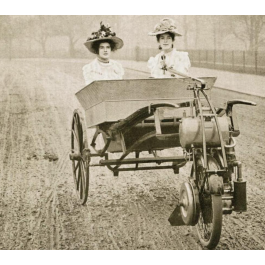|
|
Lawson's Motor WheelDescription1902 Lawson's Motor WheelLawson tricars were produced from 1900 to 1901, and built by the Crypto works. Harry J. Lawson was also involved with Coventry-Motette, the Great Horseless Carriage Company, Daimler and New Beeston. 1900-1901 Lawson ‘Motor Wheel’ Lawson Motor Wheel were produced from 1900 to 1901, and built by the Crypto works. Few, perhaps only two, machines were built. Lawson’s Motor Wheel holds a unique place in the history of early automobile technology. Invented by Charles D. “Carl” Lawson in the late 19th century, the Motor Wheel was a pioneering attempt to convert a conventional bicycle into a motorized vehicle. This invention marked an early step in the transition from bicycles to motorized transportation. The Motor Wheel was a compact and ingenious invention that demonstrated the possibilities of mechanized transportation. It was a relatively simple concept—essentially a self-contained engine in a wheel—that could be easily attached to the rear of a bicycle frame. This innovation eliminated the need for a rider to pedal, replacing human power with engine power and thereby reducing the physical effort required for propulsion. The best contemporary description of the ‘Motor Wheel’ is in The Automotor Journal of July 1900, which includes technical drawings along with the written description. The single front wheel had attached to one side of its fork a De Dion Bouton pattern 1½ hp single-cylinder air-cooled engine with somewhat out-dated hot tube ignition; the drive from this unit then passed through the hub to the two-speed epicyclic gearing. Above the wheel was the fuel tank, whilst the steering of the ensemble was by tiller with suitable control levers thereon. Although the first example saw the mechanical element attached to a horse-drawn pony-trap, production versions, as in this case, were made as complete vehicles with a tubular frame, the rear wheels were sprung, and the footbrake operated on them. The Motor Wheel was specifically designed purely for local journeying, having a top speed that only approached the then legal limit of 12 mph. Despite being marketed at £90 – a modest sum for a motor vehicle in its day – few seem to have found customers in their native land. Sources: motorcycletimeline.com ; cybermotorcycle.com ; vintage.es ; thesahb.com Detailed Information
Additional InformationAdditional Information
|





